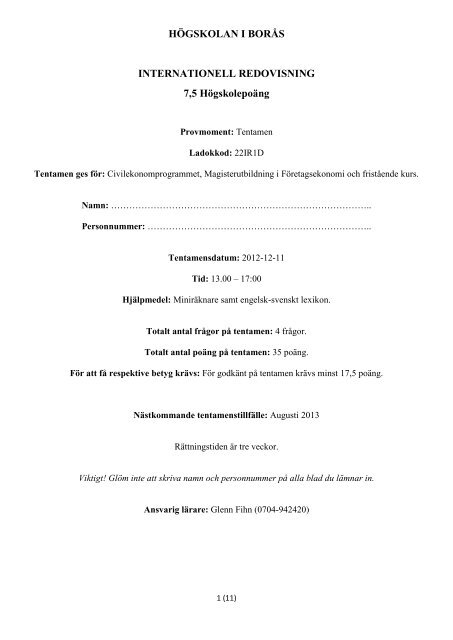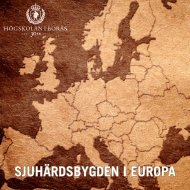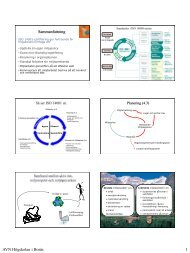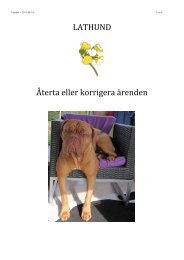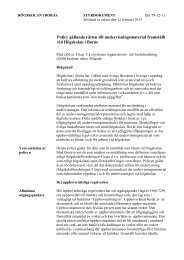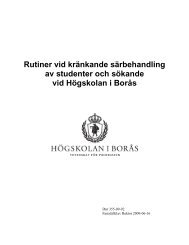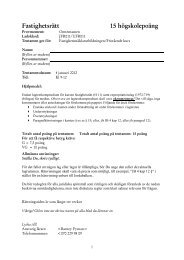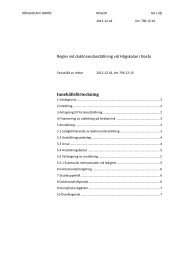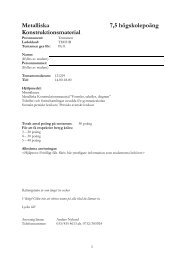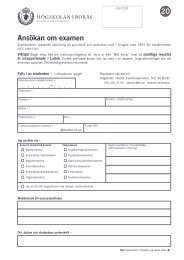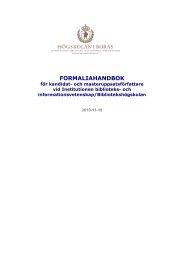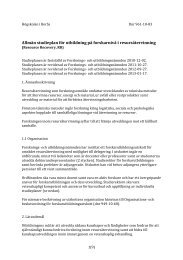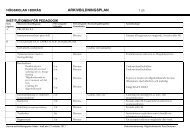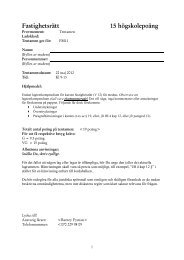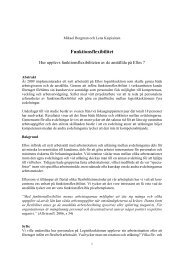HÖGSKOLAN I BORÅS INTERNATIONELL REDOVISNING 7,5 ...
HÖGSKOLAN I BORÅS INTERNATIONELL REDOVISNING 7,5 ...
HÖGSKOLAN I BORÅS INTERNATIONELL REDOVISNING 7,5 ...
You also want an ePaper? Increase the reach of your titles
YUMPU automatically turns print PDFs into web optimized ePapers that Google loves.
<strong>HÖGSKOLAN</strong> I <strong>BORÅS</strong><br />
<strong>INTERNATIONELL</strong> <strong>REDOVISNING</strong><br />
7,5 Högskolepoäng<br />
Provmoment: Tentamen<br />
Ladokkod: 22IR1D<br />
Tentamen ges för: Civilekonomprogrammet, Magisterutbildning i Företagsekonomi och fristående kurs.<br />
Namn: …………………………………………………………………………..<br />
Personnummer: ………………………………………………………………..<br />
Tentamensdatum: 2012-12-11<br />
Tid: 13.00 – 17:00<br />
Hjälpmedel: Miniräknare samt engelsk-svenskt lexikon.<br />
Totalt antal frågor på tentamen: 4 frågor.<br />
Totalt antal poäng på tentamen: 35 poäng.<br />
För att få respektive betyg krävs: För godkänt på tentamen krävs minst 17,5 poäng.<br />
Nästkommande tentamenstillfälle: Augusti 2013<br />
Rättningstiden är tre veckor.<br />
Viktigt! Glöm inte att skriva namn och personnummer på alla blad du lämnar in.<br />
Ansvarig lärare: Glenn Fihn (0704-942420)<br />
1 (11)
<strong>HÖGSKOLAN</strong> I <strong>BORÅS</strong> – (GF)<br />
Namn ……………………………………… Personnummer …………………………………<br />
Uppgift nr __ 1 __ (20 poäng)<br />
UPPGIFT: besvara nedanstående flervalsfrågor (bara ett kryss per fråga).<br />
1. International accounting can be defined in terms of which the following levels?<br />
A) Supranational organizations<br />
B) Company<br />
C) Country<br />
D) All of the above<br />
2. What is the term used to describe the possibility that a foreign currency will decrease in US $ value over the<br />
life of an asset such as Accounts Receivable?<br />
A) foreign exchange translation<br />
B) foreign exchange risk<br />
C) hedging<br />
D) foreign currency options<br />
3. As used in international accounting, a “hedge” is:<br />
A) a business transaction made to reduce the exposure of foreign exchange risk.<br />
B) the legal barrier between the various divisions of a multinational company.<br />
C) the loss in US $ resulting from a decline in the value of the US $ relative to foreign currencies.<br />
D) one form of foreign direct investment.<br />
4. A translation adjustment may be necessary when:<br />
A) notes to financial statements are converted from one language to another.<br />
B) foreign currency financial statements are converted to another currency.<br />
C) consolidated financial statements are prepared.<br />
D) hedging foreign currency.<br />
5. Why would a company want its stock cross-listed on the stock exchanges of several countries?<br />
A) To make financial reporting less burdensome for its accounting firm<br />
B) In order to use International Financial Reporting Standards<br />
C) To gain access to more financial resources than are available in its home country<br />
D) All of the above<br />
6. Which of the following is not a problem caused by accounting diversity?<br />
A) Lack of qualified international auditors<br />
B) Preparation of consolidated financial statements<br />
C) Access to foreign capital markets<br />
D) Comparability of financial statements<br />
7. In code law countries such as Germany, France, and Japan, tax law and accounting standards tend to be:<br />
A) unrelated.<br />
B) very different.<br />
C) similar.<br />
D) more confusing than those in the U.S.<br />
8. How are the concepts of professionalism, uniformity, conservatism, and secrecy classified in Gray's<br />
framework for accounting system development?<br />
A) Accounting values<br />
B) Accounting systems<br />
C) Institutional consequences<br />
D) Cultural dimensions<br />
2 (11)
<strong>HÖGSKOLAN</strong> I <strong>BORÅS</strong> – (GF)<br />
Namn ……………………………………… Personnummer …………………………………<br />
Uppgift nr __ 1 __ (fortsättning)<br />
9. The 1993 study by Doupnik and Salter found that a cluster of Latin American countries indicated that the<br />
similarity of their accounting systems was related to:<br />
A) a common currency.<br />
B) the effect of persistent inflation.<br />
C) the colonial influence of Spain.<br />
D) the colonial influence of the United States of America.<br />
10. In the Nobes classification of accounting systems, micro-based accounting systems are derived from:<br />
A) government models.<br />
B) business models.<br />
C) tax laws.<br />
D) code law.<br />
11. Which of the following statements is true about accounting convergence?<br />
A) Convergence is a synonym for harmonization.<br />
B) Convergence is the opposite of standardization.<br />
C) Convergence, unlike harmonization, takes place over a period of time.<br />
D) Convergence means developing high-quality standards in partnership with national standard-setters.<br />
12. The “Seventh Directive” issued by the European Commission is a statement to the European Union (EU)<br />
members concerning:<br />
A) adoption of the Euro as the currency used throughout the EU.<br />
B) consolidated financial statements.<br />
C) rules for valuation, financial statement disclosures, and financial statement format.<br />
D) authority of the European Commission to pass laws.<br />
13. Of the 16 members of the International Accounting Standards Board (IASB), how many work for the board on<br />
a full-time basis?<br />
A) 8<br />
B) 13<br />
C) 10<br />
D) 0<br />
14. What basis does the International Accounting Standards Board use in formulating its IFRS?<br />
A) Detailed rules to govern accounting practice<br />
B) A framework of accounting principles<br />
C) Typical tax laws of western nations<br />
D) Exceptions or unusual circumstances that require special attention<br />
15. What was the 2002 finding by the six largest public accounting firms regarding International Financial<br />
Reporting Standards?<br />
A) Of the countries surveyed, almost all planned to make their GAAP converge with IFRS.<br />
B) Very few of the countries studied planned to move their national accounting standards toward<br />
convergence with IFRS.<br />
C) There were almost as many convergence strategies as there were countries in the study.<br />
D) The countries that planned to make their GAAP converge with IFRS were predominantly western<br />
European nations.<br />
3 (11)
<strong>HÖGSKOLAN</strong> I <strong>BORÅS</strong> – (GF)<br />
Namn ……………………………………… Personnummer …………………………………<br />
Uppgift nr __ 1 __ (fortsättning)<br />
16. Which of the following inventory valuation methods commonly used in the U.S. is NOT allowed under IAS 2<br />
(Inventories)?<br />
A) LIFO<br />
B) FIFO<br />
C) weighted average<br />
D) retail inventory method<br />
17. What is the basis for choosing depreciation methods for fixed assets under IAS 16 (Property, Plant, &<br />
Equipment)?<br />
A) Tax minimization<br />
B) Profit maximization<br />
C) Useful life of the fixed asset<br />
D) Pattern of economic benefits to be derived from the asset<br />
18. IASB standards address related party transactions. According to these standards, which of the following is<br />
considered a “related party?”<br />
A) parent companies<br />
B) subsidiary companies<br />
C) key members of management<br />
D) All of the above could be related parties.<br />
19. What is one major difference between IFRS and U.S. GAAP relative to discontinued operations?<br />
A) U.S. GAAP requires that the after-tax gain or loss from operations and the after-tax gain or loss on asset<br />
disposal be shown as a combined item.<br />
B) U.S. GAAP requires the above components to be shown separately.<br />
C) IFRS requires that the after-tax gain or loss from operations and the after-tax gain or loss on asset<br />
disposal be shown separately.<br />
D) IFRS requires no separate disclosure for discontinued operations.<br />
20. Under IAS 16 (Property, Plant, and Equipment), subsequent revaluation decreases are:<br />
A) never recognized.<br />
B) credited to a revaluation surplus account.<br />
C) recognized as an expense on the Income Statement.<br />
D) first recognized as a reduction in any related revaluation surplus.<br />
21. The term “provision” as it is used in IAS 37, is most closely related to what term in U.S. GAAP?<br />
A) Contingent liability, where the outflow of resources is “remote.”<br />
B) Contingent liability, where the outflow of resources is “probable.”<br />
C) Current liability, where the outflow is difficult to measure.<br />
D) Reserve for bad debt, where the amount recoverable is “uncertain.”<br />
22. Which of the following represents a difference in the classification of current liabilities between IFRS and<br />
U.S. GAAP?<br />
A) refinanced short-term debt<br />
B) amounts payable on demand due to violation of debt covenants<br />
C) bank overdrafts<br />
D) all of the above<br />
4 (11)
<strong>HÖGSKOLAN</strong> I <strong>BORÅS</strong> – (GF)<br />
Namn ……………………………………… Personnummer …………………………………<br />
Uppgift nr __ 1 __ (fortsättning)<br />
23. Under both IFRS and U.S. GAAP, in an equity-settled share-based payment transaction, how are such<br />
payments to non-employees measured?<br />
A) at the cost of the goods or services received<br />
B) Both standards are silent as to the treatment of non-employees.<br />
C) always the fair value of the equity instrument<br />
D) at the fair value of goods or services received, if a reliable determination is available—otherwise, the fair<br />
value of the equity instrument<br />
24. Under IFRS 2, with respect to choice-of-settlement share-based payments, if it is the entity that has the right<br />
to choose between equity settlement and cash settlement, when must the entity choose the cash settlement?<br />
A) if the supplier provides services<br />
B) if the supplier provides goods<br />
C) if the entity has a present obligation to settle in cash<br />
D) The entity always has the option to choose either method.<br />
25. Under IAS 18, when it is probable that the economic benefits of interest, royalties, and dividends will flow to<br />
the enterprise and can be measured reliably, how should revenue be recognized?<br />
A) Interest income shall be recognized based on an effective yield basis.<br />
B) Royalties are recognized on an accrual basis with reference to the terms of the agreement.<br />
C) Dividends are recognized when the shareholders’ right to receive payment is established.<br />
D) All of the above govern revenue recognition under these circumstances.<br />
26. The number of U.S. dollars ($) today to buy one U.K. pound (£) six months from now is called:<br />
A) the spot rate<br />
B) the exact rate<br />
C) the forward rate<br />
D) the prime rate<br />
27. What has occurred when one company purchases the right to buy a foreign currency some time in the future at<br />
an exchange rate quoted today?<br />
A) The company has acquired a call option.<br />
B) The company has entered a forward contract.<br />
C) The currency has appreciated relative to the dollar.<br />
D) The company has acquired a put option.<br />
28. What is a “strike price?”<br />
A) the exchange rate that is used to buy a foreign currency today<br />
B) the price that will be paid for goods in a forward contract<br />
C) the exchange rate that will be used if a foreign currency option is executed<br />
D) the difference between the wholesale rate and the retail rate for foreign currency exchange<br />
29. What is foreign exchange risk exposure?<br />
A) the possibility of a loss because of changes in the value of a foreign currency<br />
B) losses caused by paying for purchased goods in a foreign currency<br />
C) losses caused by receiving payment in a foreign currency for goods sold<br />
D) All of the above<br />
5 (11)
<strong>HÖGSKOLAN</strong> I <strong>BORÅS</strong> – (GF)<br />
Namn ……………………………………… Personnummer …………………………………<br />
Uppgift nr __ 1 __ (fortsättning)<br />
30. Why must the two-transaction approach be used for recording foreign currency transactions under U.S.<br />
GAAP?<br />
A) The two-transaction approach is required under IFRS.<br />
B) U.S. GAAP requires conservatism in financial reporting.<br />
C) All other methods are excessively complicated to use and therefore obscure the essence of the transaction.<br />
D) Management made two decisions: one to sell and another to extend credit in a foreign currency.<br />
31. Homeko, Inc. is located in the U.S., but it has subsidiaries in Germany. When the euro appreciates relative to<br />
the U.S. dollar, what is the direction of the translation adjustment to consolidate Homeko's financial<br />
statements?<br />
A) When there is net asset exposure, the translation adjustment will be positive.<br />
B) When there is net liability exposure, the translation adjustment will be positive.<br />
C) The direction of the adjustment is indeterminate.<br />
D) There will be no adjustment necessary unless the difference is realized.<br />
32. Essco Ltd, a foreign subsidiary of Peako Corp., has written down its inventory to current market value under a<br />
“lower of cost or market” rule. When consolidating Essco's balance sheet into Peako's balance sheet, what<br />
exchange rate should be used for the inventory under the temporal method?<br />
A) historical rate<br />
B) current rate<br />
C) average rate<br />
D) cannot be determined with the information given<br />
33. When would the balance sheet exposure arising from the current rate method become realized?<br />
A) It is realized once the financial statements of the subsidiary and the parent are consolidated.<br />
B) It is realized any time the historical exchange rate is different from the spot rate at the balance sheet date.<br />
C) It is realized when the subsidiary is sold at book value and the proceeds are converted to parent company<br />
currency.<br />
D) It can never be realized because it is only the result of the choice of accounting methods and does not<br />
reflect real exposure.<br />
34. Under the current rate method of translating foreign currency financial statements, what exchange rate should<br />
be used for cost of goods sold?<br />
A) spot rate at the end of the year<br />
B) average rate during the year<br />
C) spot rate mid-year<br />
D) There is no single rate because beginning and ending inventory must be converted at different exchange<br />
rates than purchases.<br />
35. Which of the following is a non-derivative hedging instrument?<br />
A) forward contract on foreign currency<br />
B) foreign currency call option<br />
C) foreign currency loan<br />
D) foreign currency put option<br />
36. Which of the following is a reason for analyzing the financial statements of foreign corporations?<br />
A) making credit decisions about foreign customers<br />
B) evaluating international business combinations<br />
C) diversifying an investment portfolio<br />
D) All of the above are reasons for analyzing foreign financial statements.<br />
6 (11)
<strong>HÖGSKOLAN</strong> I <strong>BORÅS</strong> – (GF)<br />
Namn ……………………………………… Personnummer …………………………………<br />
Uppgift nr __ 1 __ (fortsättning)<br />
37. How should currency translation be done in order to appropriately compare a financial statement presented in<br />
Japanese yen to a financial statement presented in Chinese yuan?<br />
A) The temporal method should be used.<br />
B) The historical exchange rates should be used convert financial statement amounts.<br />
C) All amounts should be converted at the current exchange rate.<br />
D) Current year statements should be converted at the current exchange rate and prior year statements should<br />
be converted at prior year exchange rate.<br />
38. What is the best short-term solution to alleviate problems of financial statement analysis arising from<br />
international differences in accounting terminology?<br />
A) Require all countries to conform to IASB standards.<br />
B) Create standard financial statement terminology for all companies around the world.<br />
C) Analysts should carefully read the notes to financial statements and learn about the business environments<br />
of countries they analyze.<br />
D) Convert all financial statements into English.<br />
39. What is OIBD?<br />
A) This is the Organization of International Boards of Directors, which is attempting to harmonize<br />
accounting standards.<br />
B) It stands for “operating income before depreciation,” which some analysts use to remove the effect of<br />
international accounting standard diversity.<br />
C) It is the Organization of International Bond Dealers, whose financial analysts developed EBITDA.<br />
D) None of the above.<br />
40. Which of the following is most likely to affect an analyst's ability to make meaningful comparisons of<br />
financial statement ratios for companies in different countries?<br />
A) differences in currency<br />
B) language differences<br />
C) varying business traditions<br />
D) mathematical degrees of magnitude<br />
7 (11)
<strong>HÖGSKOLAN</strong> I <strong>BORÅS</strong> – (HP)<br />
Namn ……………………………………… Personnummer …………………………………<br />
Uppgift nr __ 2 __ (5 poäng)<br />
(Revaluation by replacement cost – IAS 16)<br />
A company purchased an item of plant for 200 000 SEK on 1 January 2001. The plant was depreciated on a<br />
strait-line basis over estimated life at 10 years. On 1 January 2003 the entity decided to revaluate its plan.<br />
No fair value was available for the item of plant that had been purchased for 200 000 kr. The replacement<br />
cost of the plant at 1 January 2003 was 300 000 kr.<br />
(a) What is the carrying value of the plant immediately before the revaluation (1 p);<br />
(b) What is the carrying value of the plant after the revaluation (1 p);<br />
(c) Suppose that the asset, which was revalued in the end of second period, is sold in 2007 for 60 000.<br />
Record the transactions and discuss about the elimination of the revaluation reserve. (3 p)<br />
8 (11)
<strong>HÖGSKOLAN</strong> I <strong>BORÅS</strong> – (HP)<br />
Namn ……………………………………… Personnummer …………………………………<br />
Uppgift nr __ 3 __ (5 poäng)<br />
The (Swedish) company Y prepares its financial statements in accordance with IFRS. The company seeks a listing on<br />
a US stock exchange. The company needs a guide for reconciliation in restating the financial statements from IFRSbased<br />
interpretation to the US GAAP. For the application of reconciliation we need to look up the general ledger for<br />
the accounting period and debiting and crediting various accounts. The balance sheet and income statement for the<br />
latest financial period are presented below.<br />
Borrowing costs:<br />
IAS 23: According to the standard the borrowing costs for putting the asset should be capitalized and increased the<br />
initial value of the assets. The Swedish company expensed the borrowing costs.<br />
US-GAAP: It should be capitalized (not expensed)<br />
Problem: In the previous year an asset was bought. The useful life is 5 years. The current interest expense (before the<br />
asset was used in production) is 25 and the previous year was 75 millions.<br />
Your task is to adjust the accounts and correct the balance respectively income sheets which are attached to this<br />
question (5 p).<br />
9 (11)
<strong>HÖGSKOLAN</strong> I <strong>BORÅS</strong> – (HP)<br />
Namn ……………………………………… Personnummer …………………………………<br />
Uppgift nr __ 3 __ (fortsättning)<br />
Balance Sheet (Under IFRS),<br />
December 31, 2004<br />
Current assets:<br />
Cash and bank<br />
Accounts receivable<br />
Inventories<br />
Total current assets<br />
Current liabilities:<br />
Bank overdraft<br />
Accounts payable<br />
Accruals and provisions<br />
Total current liabilities<br />
Net current assets<br />
Property, plant and equipment<br />
Accumulated depreciation<br />
Intangible assets<br />
Accumulated amortization<br />
Long-terms loan<br />
Share-holder equity<br />
Equity capital<br />
Retained earnings<br />
Revaluation reserve<br />
Income sheet<br />
Ended December 31, 2004<br />
Sale<br />
Less:Cost of sale<br />
Gross profit<br />
Distribution costs<br />
Adm. costs<br />
Operating expenses:<br />
Depreciation<br />
Amortization<br />
Staff costs<br />
Other operating expenses<br />
Total distribution<br />
Income from operation<br />
Interest expense<br />
Interest income<br />
Net income<br />
500<br />
7 500<br />
3 500<br />
11 500<br />
1 000<br />
5 000<br />
4 000<br />
10 000<br />
15 500<br />
9 000<br />
3 000<br />
1 000<br />
3 000<br />
4 000<br />
2 000<br />
1 000<br />
Debit Credit US-GAAP<br />
IFRS Debit Credit US-GAAP<br />
27,000<br />
14,000<br />
13,000<br />
5 000<br />
1 500<br />
1 000<br />
1 000<br />
1 500<br />
1 500<br />
11 500<br />
1 500<br />
700<br />
200<br />
1 000<br />
10 (11)<br />
27 000<br />
14 000<br />
13 000<br />
5 000<br />
1 500
<strong>HÖGSKOLAN</strong> I <strong>BORÅS</strong> – (GF)<br />
Namn ……………………………………… Personnummer …………………………………<br />
Uppgift nr __ 4 __ (5 poäng)<br />
Aktiebolaget AB MB bildar dotterbolaget AB DB i Tyskland den 1/1 år 1 och satsar 400 Euro (4 000 SEK) i<br />
det nybildade bolaget. Omedelbart vid bildandet köper AB DB in varor till lagret för 200 Euro. I övrigt<br />
gäller följande för AB DB:<br />
(a) Försäljning och samtliga kostnader uppstod jämnt fördelat under räkenskapsåret.<br />
(b) Varuinköpen uppstod jämnt fördelade under räkenskapsåret.<br />
(c) Inventarierna anskaffades vid en tidpunkt då valutakursen var 10,25 SEK/Euro.<br />
(d) Utdelningen fastställdes i mitten av december år 1 när valutakursen var 10,75 SEK/Euro.<br />
(e) Lagret vid årets slut inköptes i mitten av december år 1 när valutakursen var 10,75 SEK/Euro.<br />
(f) Det långfristiga lånet togs när valutakursen var 10,25 SEK/Euro.<br />
UPPGIFT: Räkna om balansräkningar och resultaträkning från Euro till SEK med hjälp av ”The<br />
Current Rate Method”.<br />
Valutakurser (SEK/EURO)<br />
Januari 1 År 1 10,00 SEK/Euro<br />
December 31 År 1 11,00 SEK/Euro<br />
Genomsnittlig valutakurs År 1 10,50 SEK/Euro<br />
Genomsnittlig valutakurs December År 1 10,75 SEK/Euro<br />
Valutakurs vid fastställandet av utdelningen År 1 10,75 SEK/Euro<br />
Valutakurs vid anskaffandet av inventarier År 1 10,25 SEK/Euro<br />
Valutakurs vid långfristig upplåning År 1 10,25 SEK/Euro<br />
Balansräkning<br />
BR (euro) valuta- BR (SEK) BR (euro) valuta- BR (SEK))<br />
1/1 ÅR 1 kurs 1/1 ÅR 1 31/12 ÅR 1 kurs 31/12 ÅR 1<br />
Bank 200 640<br />
Kundfordringar 300<br />
Lager 200 260<br />
Inventarier 800<br />
Ackumulerade värdeminskningar -80<br />
Summa tillgångar 400 1 920<br />
Leverantörsskulder 240<br />
Långfristiga skulder 1 200<br />
Aktiekapital 400 400<br />
Balanserad vinst 80<br />
Ackumulerade kursdifferenser<br />
Summa skulder och eget kapital 400 1 920<br />
Resultaträkning Balanserad vinst<br />
RR (euro) valuta- RR (SEK) Euro valuta- SEK<br />
ÅR 1 kurs ÅR 1 kurs<br />
Försäljning 3 000 Balanserad vinst (1/1 år 1) 0<br />
Kostnader: Årsresultat 120<br />
Kostnad sålda varor -2 400 Utdelningar -40<br />
Löner -300 Balanserad vinst (31/12 år 1) 80<br />
Avskrivningar -80<br />
Räntekostnader -60<br />
Resultat före skatter 160<br />
Skatter -40<br />
Årsresultat 120<br />
11 (11)


